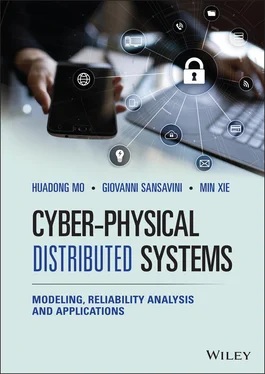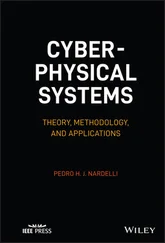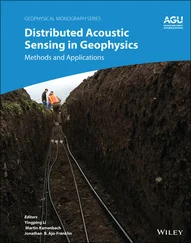Min Xie - Cyber-Physical Distributed Systems
Здесь есть возможность читать онлайн «Min Xie - Cyber-Physical Distributed Systems» — ознакомительный отрывок электронной книги совершенно бесплатно, а после прочтения отрывка купить полную версию. В некоторых случаях можно слушать аудио, скачать через торрент в формате fb2 и присутствует краткое содержание. Жанр: unrecognised, на английском языке. Описание произведения, (предисловие) а так же отзывы посетителей доступны на портале библиотеки ЛибКат.
- Название:Cyber-Physical Distributed Systems
- Автор:
- Жанр:
- Год:неизвестен
- ISBN:нет данных
- Рейтинг книги:3 / 5. Голосов: 1
-
Избранное:Добавить в избранное
- Отзывы:
-
Ваша оценка:
- 60
- 1
- 2
- 3
- 4
- 5
Cyber-Physical Distributed Systems: краткое содержание, описание и аннотация
Предлагаем к чтению аннотацию, описание, краткое содержание или предисловие (зависит от того, что написал сам автор книги «Cyber-Physical Distributed Systems»). Если вы не нашли необходимую информацию о книге — напишите в комментариях, мы постараемся отыскать её.
SYSTEMS
Gather detailed knowledge and insights into cyber-physical systems behaviors from a cutting-edge reference written by leading voices in the field Cyber-Physical Distributed Systems: Modeling, Reliability Analysis and Applications
Cyber-Physical Distributed Systems
Cyber-Physical Distributed Systems
Cyber-Physical Distributed Systems — читать онлайн ознакомительный отрывок
Ниже представлен текст книги, разбитый по страницам. Система сохранения места последней прочитанной страницы, позволяет с удобством читать онлайн бесплатно книгу «Cyber-Physical Distributed Systems», без необходимости каждый раз заново искать на чём Вы остановились. Поставьте закладку, и сможете в любой момент перейти на страницу, на которой закончили чтение.
Интервал:
Закладка:
Using the underlying theories of systems science, such as probability theory, decision theory, game theory, control theory, data analysis, organizational sociology, behavioral economics, and cognitive psychology, this book addresses foundational issues central across CPS applications, including: (I) System Verification – How to develop effective metrics and methods to verify and certify large and complex CPSs; (II) System Design – How to design CPSs to be safe, secure, and resilient in rapidly evolving environments; (III) Real‐Time Control and Adaptation – How to achieve real‐time dynamic control and behavior adaptation in diverse environments, such as distribution and in network‐challenged spaces; (IV) System of Systems – How to harness communication, computation, and control for developing new integrated systems, reducing concepts to realizable designs, and producing integrated software–hardware systems at a pace far exceeding today's timeline.
In general, this book has four essential topics. Chapters 1and 2provide readers who do not have a sufficient background on CPSs with a general introduction, research gaps, and representative CPS applications, including CPS modeling, statistical analysis of CPS performance, probability prediction of CPS state, robust CPS control techniques, and management and optimization of CPS reliability and risk. Chapters 3and 4mainly concern the robust control of CPSs by designing optimal control strategies, or resource management to enhance robust performance and improve the reliability index against time delays and packet dropouts, which are the inherent properties of open communication networks. Chapter 5addresses the data‐driven degradation modeling of aging physical (actuators) and cyber (sensors) components of CPSs, and corresponding optimal maintenance plans to improve the reliability of CPSs. Chapters 6and 7investigate the cyber security of CPSs, introduce the general concept of cyberattacks, design vulnerability models, and risk assessment procedures, and develop game‐theoretic mitigation techniques and Bayesian‐based cyberteam deployment strategies.
More specifically, Chapter 1summarizes the evolution from the traditional physical system to the CPS and provides an overview of dynamic and dependent behaviors to be addressed in the subsequent chapters of the book. The introduction discusses some important and recent challenges in improving traditional physical systems in terms of CPSs, popular research trends in evaluating the impacts of CPSs on society, and opportunities for enhancing the performance of realistic applications, which are primarily network control systems. The detailed properties, requirements, and vulnerabilities of utility systems are also introduced. The reasons why the proposed modeling techniques work is important in a field that would be difficult to deal with if the cyber and physical domains were treated separately.
In Chapter 2, readers acquire the basic knowledge to be used in data‐driven statistical modeling, the estimation of the probabilistic CPS state, and a comprehensive framework for conducting reliability analysis of CPSs. In addition, this chapter introduces how to use to historical data to validate the performance of the proposed CPS model, and how to use performance indexes to facilitate the resilient design of CPSs. Moreover, it also demonstrates a real‐time test platform for various industrial applications and the standard procedures for improving real‐time criteria.
Chapter 3focuses on the stability of CPSs, where decision makers perform dynamic control and adaptation based on real‐time data from sensors. It provides two examples of the design of the controller parameters for robust system performance. The first example illustrates the development of adaptive control for wide‐area measurement power systems, where communication delays are predicted to provide delay compensation for additional frequency stability. In addition, the integration of control theory, power engineering, and statistical estimation is discussed. The second example is an extension of wide‐area measurement power systems from a dedicated communication network to open communication networks, where occurrences of communication delays and packet dropouts result in the failure of the power management system from renewable energy resources. Explicit and implicit methods are then designed for system integration, analysis, and improvement.
Chapter 4illustrates a system‐of‐systems framework for the reliability of distributed CPS accounting for the impact of degraded communication networks. This is quite different from the focus of Chapter 3, which mainly covers the stability of CPSs from a control perspective. Based on the collected dataset, the degradation path of open communication networks is described in terms of stochastic continuous time transmission delays and packet dropouts. A distributed generation system with open communication infrastructure is used as an example, which is a multi‐area distributed system that is more complicated than the single‐area power system presented in Chapter 3. An optimal power flow model is proposed to generate consecutive time‐dependent optimal operation scenarios for a distributed CPS. Quantitative analysis is carried out to evaluate the effect of networked degradation on the reliability indexes of CPSs, e.g., energy not supplied and operation cost. A prediction method for reconstructing missing data is proposed to mitigate the influence of packet dropouts, which is universal and applicable to most current industrial applications.
Chapter 5models the functional dependence between stochastic aging actuators and sensors within their operating environments. This dependence is considered in the time domain, causing a distinct degradation status in the actuators and sensors. Reliability modeling of the stochastic effects and effective maintenance activities are discussed for different types of CPSs, including the cooling system in a nuclear power plant, a one‐area energy system with a single generation group, and a multi‐area energy system with several different generation groups.
Chapter 6explores the concepts, principles, practices, components, technologies, and tools behind risk management for cybersecurity of CPSs, providing practical experience through a realistic case study that focuses on the methodologies available to identify and assess such threats, evaluate their impact, and determine appropriate measures to prevent, mitigate, and recover from any threat or disruptive event so that the operations and profitability of the organizations are maintained and maximized.
Chapter 6presents the framework of CPSs under cyberattacks from a game‐theoretic perspective, which makes use of statistical data to model the behavior of cyberattacks and study the dynamic game between the network defender and attacker at the system level. For current utility CPSs, cyber threats from supervisory control and data acquisition (SCADA) systems, and spear‐phishing attacks on the accounts of internal employees to gain access to dedicated communication networks are investigated in Chapters 6and 7. In addition, these chapters focus on how to modify the basic modeling techniques presented in Chapter 2to describe cyber vulnerabilities, such as seizing the SCADA system under control, disabling/destroying IT infrastructure components, and denial‐of‐service (DoS) attacks on the control center in smart grids. Based on historical data for IT security spending, the cost of launching distributed DoS attacks, and the occurrence probability of cyber event losses, the contest intensity between the attacker and defender can be accurately predicted for the next period to guide the design of an effective network protection plan, that is, a game‐theoretic protection plan and a Bayesian‐based cyberteam deployment.
Читать дальшеИнтервал:
Закладка:
Похожие книги на «Cyber-Physical Distributed Systems»
Представляем Вашему вниманию похожие книги на «Cyber-Physical Distributed Systems» списком для выбора. Мы отобрали схожую по названию и смыслу литературу в надежде предоставить читателям больше вариантов отыскать новые, интересные, ещё непрочитанные произведения.
Обсуждение, отзывы о книге «Cyber-Physical Distributed Systems» и просто собственные мнения читателей. Оставьте ваши комментарии, напишите, что Вы думаете о произведении, его смысле или главных героях. Укажите что конкретно понравилось, а что нет, и почему Вы так считаете.












